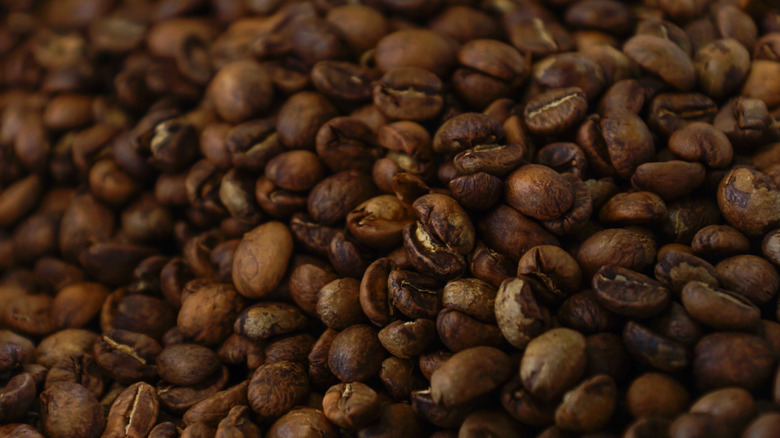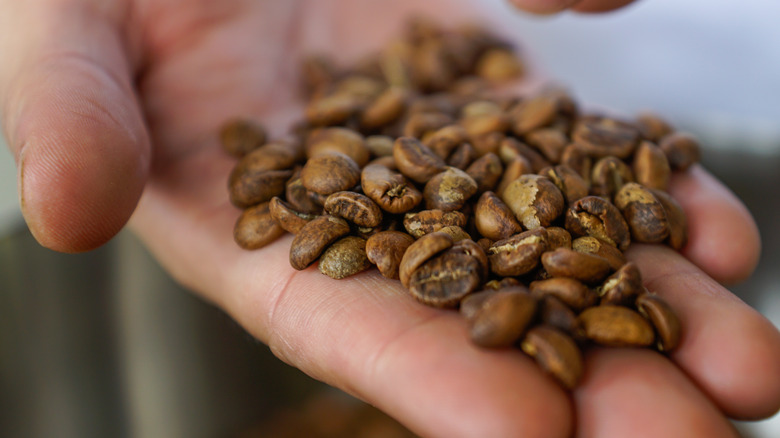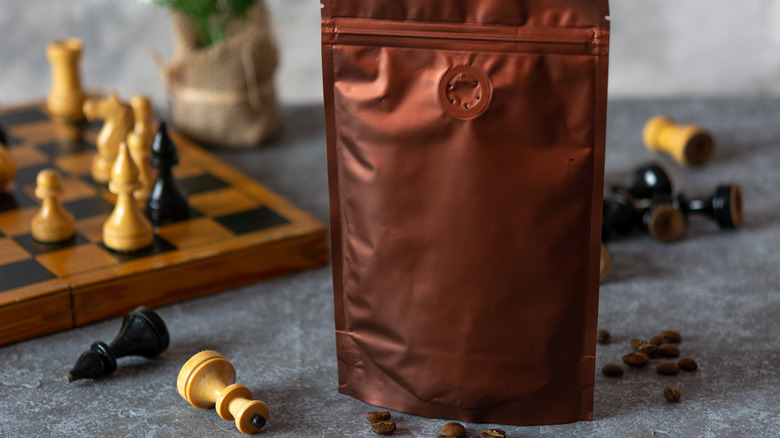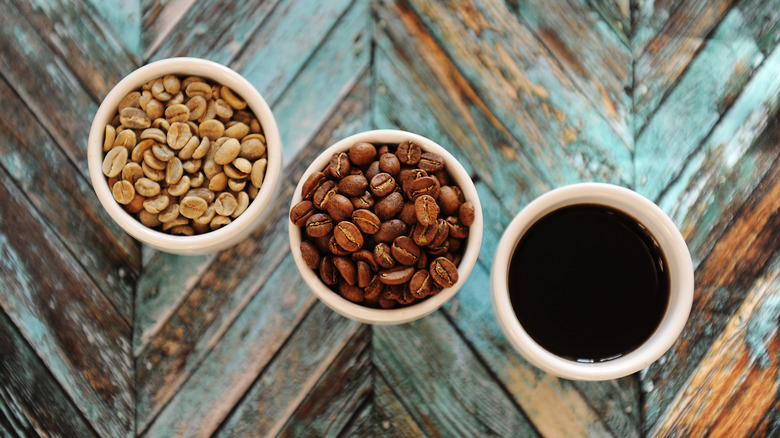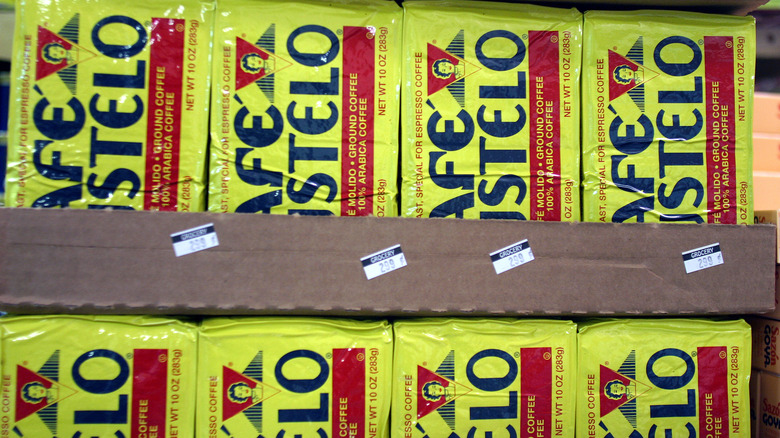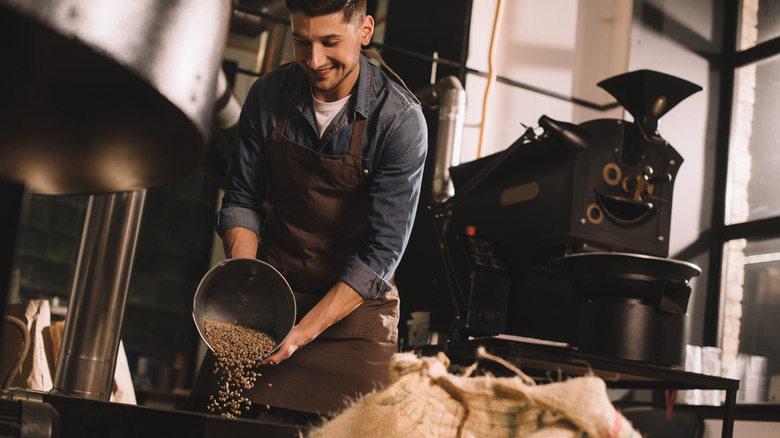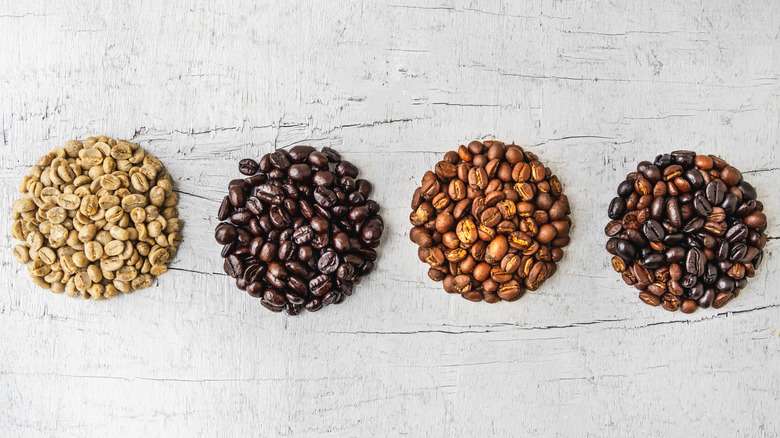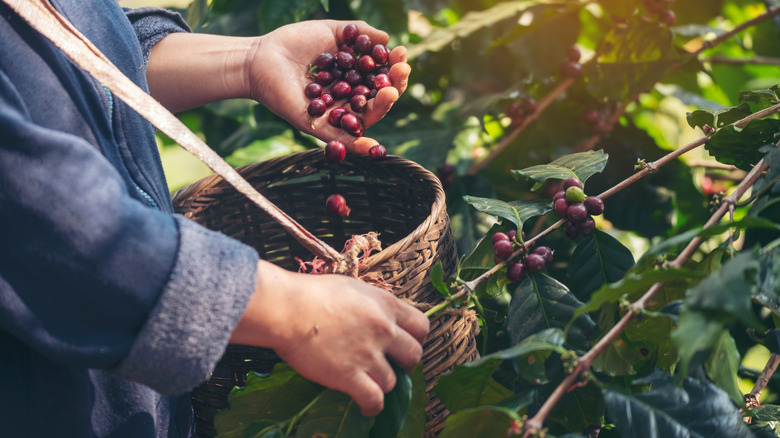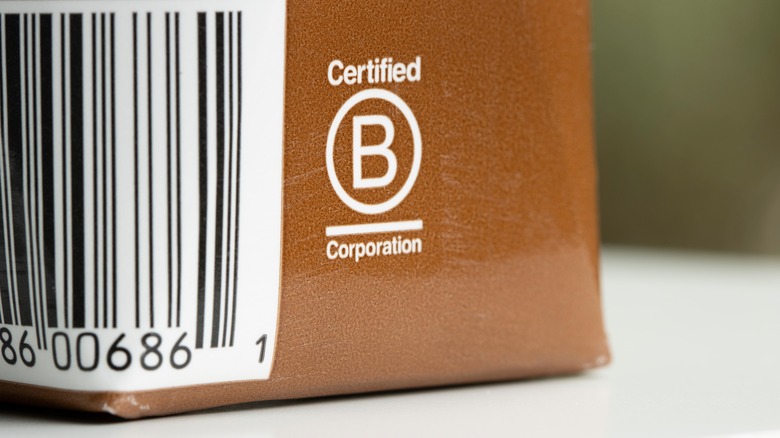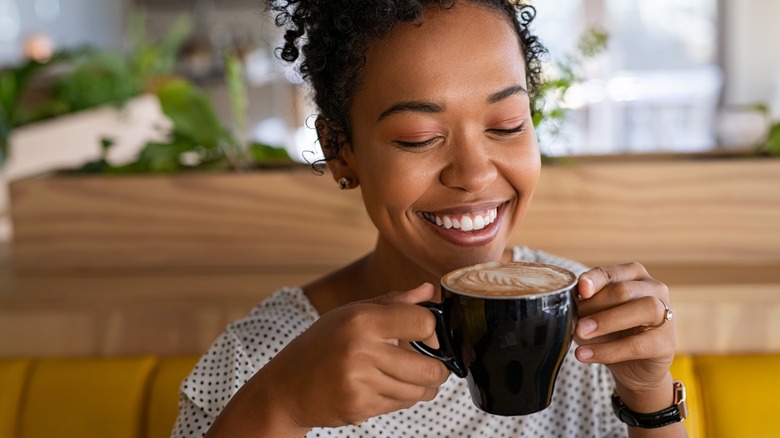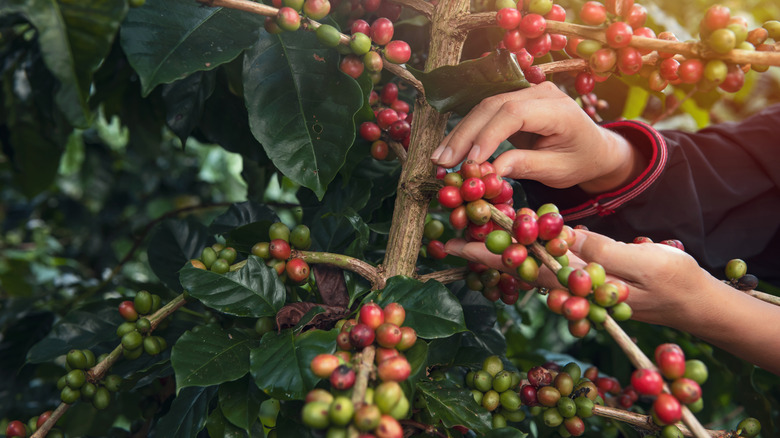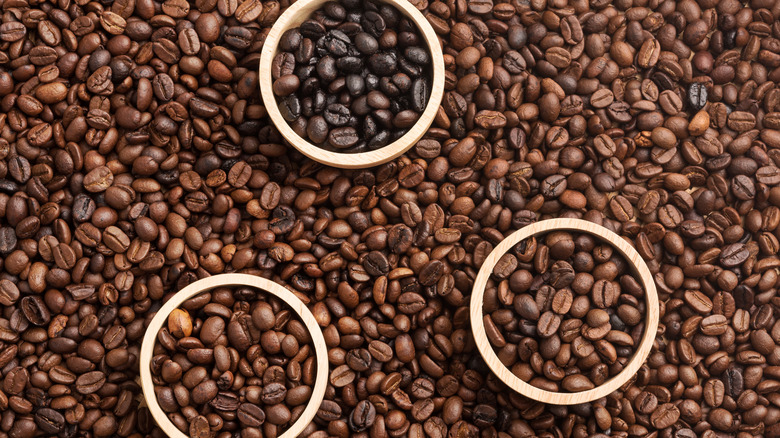14 Signs That Indicate A Great Premium Coffee
A great cup of premium coffee is one of the best pairings for a sunny morning. The smell hits the nostrils with its seductive allure, wiping clean your eyes of any remaining sleep. The first sip of full-bodied, rich, and roasted brew quickly brings the brain into focus. Coffee is the kick your morning needs, if not one of the best parts of waking up. With that said, the better the bean and brew, the better its effects on you.
When it comes to quality, coffee is typically separated into three main types: gourmet, premium, and specialty. Despite its fancy name, gourmet is generally used as a buzzword marketing tactic and doesn't actually indicate whether a coffee is high quality or not. On the higher end, specialty, of course, refers to top-tier beans and craft brews. Lastly, sitting between the two is premium coffee, which has a more refined taste than gourmet, yet doesn't carry the price tag of specialty.
Under the umbrella of these three, there are many different types of coffee. Since gourmet brands don't offer the best taste, and specialty is often too pricey for everyday consumption, premium coffee is the recommended option for a quality experience that still fits your budget. To help us zero in on signs that indicate a great premium coffee, we chatted with Ezequiel Guzman, the Coffee Director for WME Agency in Beverly Hills, California. With his expertise, you'll always choose coffee that offers a rich and full-bodied experience.
Quality coffee brands have transparent websites
One of the most immediate indicators of a product's quality is its website. Sorry small business owners, we know that sometimes your product is great even though your website is still a work in progress. That's part of the reason why having a cleanly-designed and trustworthy website is important; it takes time and money to create one, and the effort a brand puts into its website is an indication of the effort put into everything they do. This goes for every product, not just premium coffee.
A quality website includes great photography and thorough information about what, where, and how the products are manufactured. Transparency is key. It should also feature an About Page, where you can learn about the company's history and passion for quality. Even recipe recommendations and "best ways to enjoy" are great indicators of authentic premium coffee. A business doesn't have to be a hundred years old in order to be a trusted retailer, it just needs a transparent online presence that answers the questions customers have.
Premium beans look and feel like quality
If you have enough restraint to not let your nose get the best of you, you'll have the patience to inspect your beans before purchasing them. There are certain things to look out for when determining whether or not a bean is quality. According to our resident coffee expert Ezequiel Guzman, "If a bean has any sort of sheen or oils, it means they are over-roasted past second crack — they've lost all flavors that make them unique." When coffee is roasted, shifts in temperature cause chemical changes called first and second crack.
Literally named after the sound they make, the first crack occurs around 385 degrees Fahrenheit while the second typically happens around 435 degrees Fahrenheit. Each is essential to developing the coffee flavor. Following the first crack, the heat begins to make oil rise from the beans. If keen attention isn't paid during this process, the roaster can potentially burn away the coffee bean's subtle flavor notes. You'll know your premium beans are high quality if they're oil-free, crack-free, and vibrant in color without blemishes.
Aroma plays a big role in premium coffee
No matter what, you'll always smell coffee before you see it. When the sweet and toasted aroma of brewed coffee hits, it grabs your attention immediately, pulling you to investigate. Aroma is a major player in the world of coffee. In fact, there are over 800 known aromatics in coffee alone. It's used by professional tasters, also known as cuppers, as one of the primary indicators of quality too.
Aroma impacts your entire coffee experience; whether it's rich and flavorful or acidic, the smell will carry each of those subtle notes. It's referred to as a coffee's bouquet or nose, and is separate from its fragrance, which comes from the gasses and vapors that coffee emits. Without aroma, coffee would just be another boring bean. Basically, if the smell isn't pungent and powerful, it's not quality, and it's definitely not premium. That's why it's important to keep coffee beans fresh. Their addictive fragrance was made especially for our nose's enjoyment.
Coffee bags with valves are typically higher quality
To preserve the aromatic goodness coffee offers, it needs to be packaged properly. CO2 is the key chemical reaction behind the smell we love so much; as it leaks from roasted beans, their aroma, flavor, and distinct characteristics escape along with it. The more CO2 that escapes, the less flavorful your coffee beans become, leading to a less-than-desirable experience. Without their delectable aroma, it's hard to know if your coffee beans are high quality.
To combat bland brews and extend the shelf life of premium coffee, packages are generally equipped with a one-way degasser valve. Beans begin to degas immediately after being roasted, which is when CO2 is produced. It was created to release gas from the package, without allowing air inside. As such, it's become an increasingly popular indicator of coffee quality. Next time you're trying to decide which brand to go with, make sure to check the package for a degassing valve. Don't get gassed by fancy packaging without one.
Look for a grading between 60 to 70 points
One essential coffee term you should know is "cupping score." It's a process where cups of freshly brewed coffee are evaluated and scored in order to determine which quality category it falls into. Of the three main types of coffee, gourmet scores between 50-60, premium lands between 70-84, and anything higher than that is specialty coffee. The reason premium beans aren't considered specialty is because the ones with defects aren't separated.
Defects aside, premium coffee beans still undergo a rigorous process and can rival some of the best specialty coffee options in flavor. While not as costly as specialty, premium is definitely not for penny-pinchers. The taste alone is worth the extra cream. Reputable coffee roasters usually share the cupping scores on their website, and scores are also easily searchable online. If you're curious about your caffeine, be sure to inquire about the cupping grade next time you're looking for the real deal.
Premium costs less than specialty, but more than gourmet
Naturally, with three different grades of coffee types, there are three varying costs. While it's never mandatory to break the bank for a great cup of coffee, paying a few more bucks for better quality is always recommended. Premium coffee is an excellent alternative to the more expensive specialty brands. You can easily find many that pack the same soothing and full-bodied flavor.
Amazing taste notwithstanding, we understand how bad the price of coffee has become. But why let a little inflation keep you from enjoyment? A quality cup of joe can make the difference between a sunny forecast versus a gloomy overcast. Next time you go shopping, compare and contrast the cost of their coffee selection, then check to see whether certain brands should be considered premium. The average price range will be a good indicator of which coffee to choose.
The packaging should include the roast date
Another indicator of quality premium coffee should always be located directly on the packaging. Unless you have one of those miraculous budget-friendly brands that happen to taste delicious, if your coffee's package doesn't have a roast date on it, think about replacing it with another. As one could easily surmise, the roast date refers to the day that the coffee beans were roasted. The closer you purchase to a bean's roast date, the fresher the flavor and better the taste.
It's a safe bet to assume that a package without a roast date isn't the best coffee quality. Although there are other factors that can impact freshness, like package material and exposure to air, identifying the roast date is a simple and consistent box to check off. Take it from roastmaster Guzman: "Coffee bags should always have the roast date somewhere on them." It's definitely something you should look for next time you buy coffee. Look at that: Now you're one step closer to being a premium coffee pro.
Learn the difference between light, medium, and dark roasts
Each of the three main types of coffee can be further divided into three different kinds of coffee roasts: light, medium, and dark. The pleasantly addictive aroma you associate with coffee is only produced after the bean has been roasted. Before that, it's just a green-colored bean that tastes closer to bitter herbal tea than the coffee you're familiar with. Temperature determines what type of coffee roast you end up with.
Of course, lighter roasts are cooked for shorter periods and lower temperatures between 380 to 400 degrees Fahrenheit. It tastes more earthy than medium and dark roasts, still retaining much of its original flavor. For medium, the most popular type, coffee beans must be roasted at around 400 to 430 degrees Fahrenheit. Medium roast coffee tends to carry more sweetness than light roasts, giving it a well-rounded flavor profile. Under temperatures around 430 to 450 degrees Fahrenheit, dark roasts carry more of a toasted-pine flavor, concealing the bean's grassy origins.
When determining whether or not a premium coffee is up to par, make sure the roast type exhibits these qualities. Whichever you favor, you'll find pretty much the same caffeine content in each. Whip that fun fact out the next time you visit your local café; it'll surely impress the barista.
How the beans are grown determines quality
To achieve true quality, it takes careful consideration from root to plate. Coffee farming is akin to wine, it's a refined process that relies on balancing the nutrients in the soil, the perfect weather conditions, and even the right altitude. Premium coffee in particular is commonly grown in microclimates that have distinct atmospheres from the surrounding areas. Each step of the way impacts the end result; a coffee's terroir affects its characteristic taste, roundness, and smell.
While the term "terroir" is typically associated with wine, the same practices occur in the coffee industry. Terroir refers to a coffee bean's natural environment, its topography, and even climate; three things that matter for coffee beans to grow into beautiful vessels of caffeine. Premium coffee requires specific levels of heat and humidity. Reputable coffee roasters usually let you know how and where their coffee beans are sourced on their website. With that said, where coffee grows is only a small part of what makes quality beans, according to Guzman "It doesn't really matter where a bean is grown for it to be quality," he says. "It's more about the process and time that was invested into harvesting the best of the crop."
Reputable brands typically have special certifications
Despite how it may sometimes seem, owning a reputable food and beverage business requires paying for a lot of licenses and certifications. You know those tiny logos you find on products? Brands have to pay for those. Certifications are additional checks and balances that not only keep quality up to code, but also contribute to a brand's trustworthiness. Without these standards, it'd be challenging to tell the difference between fair trade and regular.
While it's impossible to completely avoid being a victim of false advertising, looking for certification labels is a quick and easy way to determine whether or not you're getting the good stuff. Products could falsely advertise anything and we'd be none the wiser. In addition to quality, brands that center around sustainability and organic farming often carry labels. Some common sustainable coffee labels you'll come across are "USDA Organic," "Fair Trade," and "Ethically Sourced."
Choose brands associated with high quality
This indicator should come as no surprise, yet still should be mentioned. Quality brands typically are known for selling quality products, and each offering carries a track record and searchable customer reviews. What are buyers saying about the coffee? Reviews are almost always the quickest way to get the skinny on the things we buy. While the best coffee brands are a matter of preference, there are many roasters worth trying that put love and care into their beans.
Run a quick search on the coffee brand you're considering purchasing. Have they recalled any products recently? Does their name pop up in any undesirable headline? In truth, running a company comes with many challenges, so a hiccup here and there is understandable. On the other hand, if you come across numerous red flags, it's probably a good idea to try another brand. Honestly, this is quality control 101.
Premium coffee flavor is rich and dense
As mentioned, premium coffee is available in light, medium, and dark roasts, with each having its own flavor characteristics. After you've gained a decent understanding of the differences between each roast type, you know what to look for in flavor. In either case, the coffee should be well-rounded, ranging from mild to robust depending on the roast level. True premium coffee hits every flavorful note, bringing them together in delicious harmony.
The flavor in coffee comes from the interaction between acidic and aromatic compounds. The Maillard reaction gives coffee its roasted taste and color; it involves a chemical reaction between natural sugars and amino acids that causes a browning effect. In addition to how the coffee bean was grown, how it's brewed plays a big part in how it ultimately tastes. If a cup lacks the punch of flavor your roast is known for having, your beans are bust.
Purchase single origin coffee for more exclusive taste
Single origin beans are untainted by other flavors, making them an ideal experience for dedicated coffee connoisseurs that may otherwise scoff at the idea of drinking coffee blends. These flavors aren't for the faint of heart — they're raw, original, and often contain pronounced flavors that more commonly attract coffee risk-takers. Single origin beans require delicate roasting, as improper heat exposure will burn away many of the subtle qualities that make them unique.
The taste carries with it the characteristics of the environment it's harvested from, offering a wholly individual experience. If you're interested in flavors from a specific region, small town, or faraway location, single origin coffee is the one for you. You'll not only get a snapshot of what life is like in another country, but you'll also be rewarded with quality premium coffee. Another great thing about single origin coffee is that purchasing it often supports the livelihoods of small farmers that work so hard to ensure our mornings include premium joe.
Premium coffee blends offer balanced flavor profile
Less adventurous coffee lovers tend to prefer blends rather than the unpredictable nuances of single origin beans. Coffee blends are carefully paired by expert roasters that have given serious consideration to creating a balanced flavor profile. Not just anyone can make a premium coffee blend, it takes knowledge and a developed palate.
One coffee bean type can be chosen for its acidity, while another can be valued for its fruity undertones. The best blends complement and elevate the characteristics of each individual bean, creating a delicious marriage of flavor. Simply put, it offers a more consistent taste. Unlike single origin beans grown in one location, coffee blends let you experience tastes from around the world and back.
Another area where coffee blends have single origin beans beat is availability. As the name suggests, single origin beans come from one place, and as a result, can only be produced in small batches. With coffee blends, combinations can produce larger quantities of coffee. That's why it's more popular. Either way, whether you're a committed coffee commando or just enjoy it for its energy-boosting powers, knowing how to spot premium coffee is a handy tool to have. Lastly, Guzman has a great tip for finding quality coffee: "If a shop has a pour-over on their menu, it's usually a good indication that they put time and care into each cup they make."
